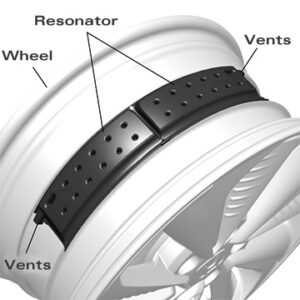Honda develops sound cancelling resonators reducing tire noise
Tokyo, Japan – The periodic noise from the tires when driving on a highway can be annoying. This noise is caused by resonance in the tires’ hollow cavities when driving over unevenness on the road surface. This has been a serious problem, especially for an automobile manufacturer pursuing comfortable mobility. Noise-reducing wheels use hollow resonators to suppress unwanted resonance, to provide a quiet, comfortable ride.
Noise generated within the tire is due to pipe resonance, similar to the sound produced when bouncing a basketball or volleyball on the floor. With cars, the pipe resonance and accompanying vibrations are transmitted from the wheels to the suspension, and into the cabin resulting in unwanted, unpleasant noise.
Honda was determined to suppress this noise. Realization of the difference in sound frequency when bouncing a basketball and a volleyball led to the understanding that pipe resonance frequency depends on the shape and capacity of the air container. As the tire size is known, pipe resonance frequency can be determined. By generating sound that cancels out that frequency, pipe resonance can be suppressed.
Honda then considered utilizing Helmholtz resonance, which is a phenomenon that generates sound when, for example, a person blows across the top of an empty bottle. The shape and air capacity of the bottle determine the sound frequency.
When pipe resonance occurs, the resonator begins to resonate at the same frequency, causing vibration due to air disturbance near the vents which allow air to pass through. This effectively cancels the pipe resonance sound.
Noise-reducing wheel resonators are made from lightweight resin, and through a unique, well considered structure, are fitted to the wheel rim without the use of connecting parts such as bolts. Centrifugal force actually secures the resonators to the wheel more firmly. The resonators can withstand 1,500G during high-speed driving, and bond to the wheel stronger without losing their shape.
Damping material and dynamic dampers, used in conventional pipe resonance reduction, are not required, thus reducing the car’s weight. This also contributes to lowering unsprung weight, vital for vehicle performance.
Honda has continued development, since it made the world’s first practical noise-reducing resonator in 2010. The resulting 2nd generation noise-reducing wheel’s resonator is as efficient as the first generation, but only half the weight. Still, Honda is not satisfied with this, and continues the research to realize an even more quiet, comfortable, fuel efficient and high performing car.

